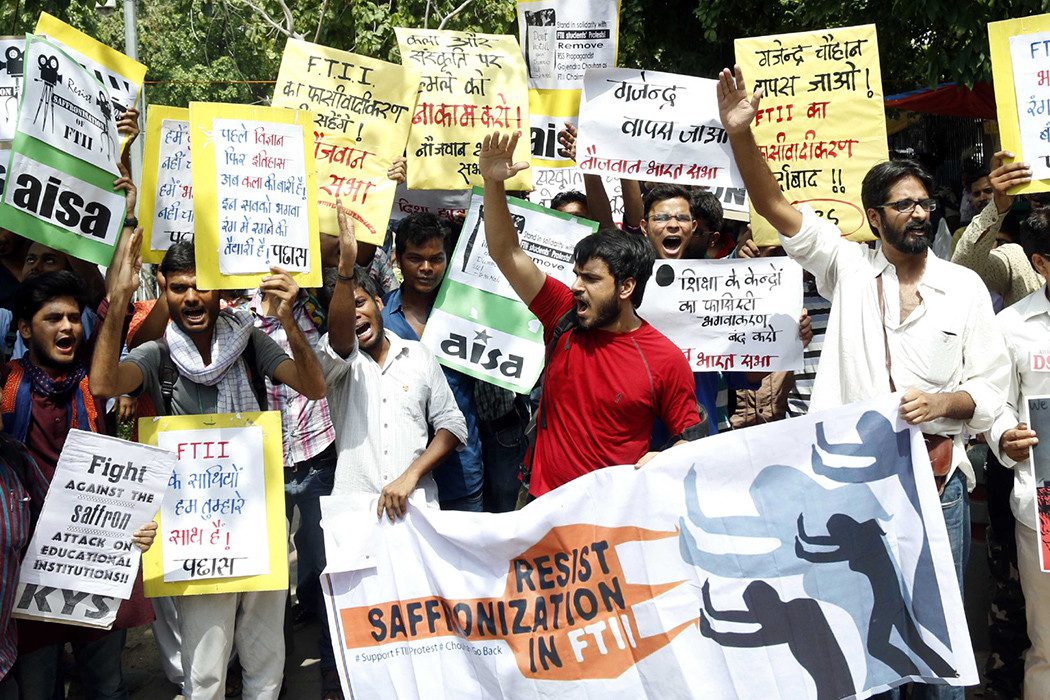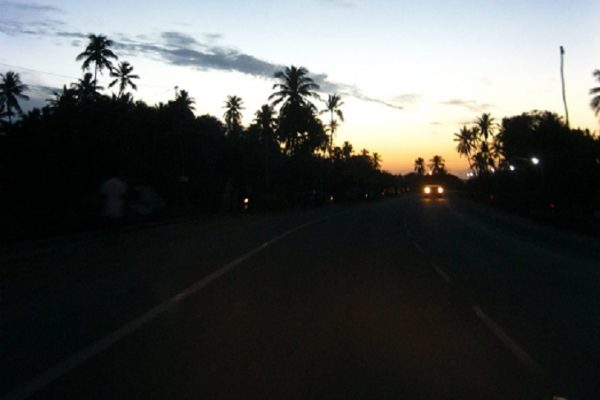Two recent incidents demonstrate the megalomania and xenophobia of the paranoid Indian state, says Amit Sengupta.
It is the land of Buddha and Gandhi, said our Dear Leader in London, when faced with a sharp query on intolerance by a reporter. He could very well have said that it is the land of Buddha and Gandhi where you can’t wear a FTII T-shirt, come what may. Especially when you are in the hallowed precincts of the International Film Festival of India (IFFI) in Goa, with Gajendra Chauhan’s halo as backdrop.
The irony is that this FTII cinematography student, who has been attending IFFI year after year, watching films from 9 am to 11 pm day after day, inhaling the intangible kaleidoscope of world cinema, himself went over to the cops when he overheard the cuss word: “FTII”. However, the cops seem to have lost it.
At once threatened, as if a Daesh terrorist had emerged, they allegedly shot back: Are you from FTII? The student apparently said, yes, what’s wrong? Look, I am even wearing a FTII T-shirt. It’s cool.
This is not simply Big Brother. This is state terrorism and schizophrenia, manifest in its most brazen reincarnation.
So that was it. He was roughed up, hauled into custody, his wallet searched and his life turned upside down, his cell phone deconstructed, including his email account and picture galleries. His legitimate delegate card was scrapped and he was banned from accessing any film or film buff in the vicinity of the fest.
This is not simply Big Brother. This is state terrorism and schizophrenia, manifest in its most brazen reincarnation.
Earlier, all the “Make in India” FTII films were blocked, the institute’s students were not allowed to enter the fest, one intern was unceremoniously sent back, and there seemed to be a “red alert” about anything to do with students and FTII. The cops and bureaucrats seem to be following a Gestapo drill: You see a young, eclectic bright spot in the map, just go after him or her. All that was left was to declare a “FTII curfew” in Goa, as they did in Belgium after the Paris attacks.
The cops and bureaucrats seem to be following a Gestapo drill: You see a young, eclectic bright spot in the map, just go after him or her.
Two nonviolent former students were still able to penetrate the high security chakravyuh with placards, shouting slogans when Anil Kapoor was in the midst of a dance item. That the VIPs and glitterati froze for a few moments, and the youngsters were forcibly and quickly “removed” by the “short, nasty and brutish” cops only added to the halo of the paranoid Indian State, currently under siege by its own “selfie” obsessions of both megalomania and xenophobia.
Indeed, the question remains. Why was this mighty schizophrenic repressive apparatus unleashed on young, creative, dissenting minds—to achieve what lofty goal of vibrant India? To protect the great name and legacy of a man called Gajendra Chauhan, a C-grade actor wallowing in his own mediocrity, with neither professional credibility nor talent, with a string of low life dirty movies under his belt? Just because he is an “RSS favourite”?
The FTII T-shirt might become a fetish-like object in the days to come. To wear one would be as good as wearing a Che Guevara T-shirt in a RSS shakha.
Why was this mighty schizophrenic repressive apparatus unleashed on young, creative, dissenting minds—to achieve what lofty goal of vibrant India? To protect the great name and legacy of a man called Gajendra Chauhan, a C-grade actor wallowing in his own mediocrity, with neither professional credibility nor talent, with a string of low life dirty movies under his belt?
In contrast, what if I wear a “Gai Hamari Mata Hai” T-shirt—the holy cow, red tika on the forehead, bells tinkling, with a message in plastic engraved on my not-quite-56-inch chest: “Don’t Kill the Cows”? Will the cops come and get me too?
Two young artists ended up being rudely hauled up by cops who don’t care two hoots about “art for art’s sake”, or avant-garde anarchism in postmodern times. They dared to hang a symbolic cow made of Styrofoam in time and space with a balloon in an art show in Jaipur. Styrofoam is expanded plastic, often white, made from polystyrene. The harried cops and breaking news TV channels perhaps thought that it was real cow—live. However, the truth is, like the FTII films banned in the IFFI, the cow in Styrofoam was also telling a story.
That in the open-to-sky garbage dumps on the streets across India, where they are left to their fate, cows end up swallowing deadly, murderous objects: polythene, plastic, medical equipment, drug, gutka and plastic wrappers, toxic substances, rotten food and veggies, broken glass, rubber and leather, among other obscure objects of desire. The non-biodegradable material enters their intestines and clogs their digestive system.
Two young artists ended up being rudely hauled up by cops who don’t care two hoots about “art for art’s sake”, or avant-garde anarchism in postmodern times.
That yes, often, they die slowly and terribly, in abject pain. Surely, this is no way to die. Even for our holy cow, in a motherland where once rivers of milk and ghee used to flow!
So what is the moral of the story? One, in the land of Buddha and Gandhi, don’t ever wear a FTII-T shirt. And, second, never ever hang a Styrofoam cow in the air with a message that plastic kills.


